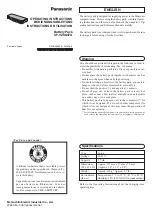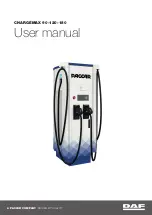
18
◎ NEW BATTERY CHARGE
◎ Pb BATTERY SAFETY
When the new NiCd/ NiMH are charged at the first time, charge process might be termi-
nated within minutes, it is not because charger or battery have a problem, but because
battery is not stabilized yet. In this case, you need to charge battery after increasing the
delta peak value or to charge battery after discharging and cooling down battery.
Do not use the battery, if the charged capacity of battery exceeds battery capacity in
specification. If such a phenomenon arises, repeat to charge and discharge more over 5
times and charge again. Such a phenomenon might arise till the third time charge.
Pb battery needs to be charged every day. If the charged capacity of battery is dropped
below 50%, this battery might not be recharged. The average charge time of Pb battery
is 4~5 hours. Do not charge Car battery, the charger might get the serious damage
◎ LiIon, LiPo, LiFe BATTREIES SAFETY
1. Always charge the batteries that have Lithium ion or Lithium polymer mark and do not charge
the batteries that have Lithium mark. Failure to do so will damage the batteries and may
cause fire or personal injury.
2. Always charge the batteries that the cell voltage ( 3.3V / 3.6V / 3.7V ) is written
3. Ensure that the charger and battery are placed on a non-flammable surface whilst charging.
4. Never charge Lithium ion/Polymer/Fe batteries inside a vehicle whatever the circumstances.
5. Always ensure that the charger is correctly set for the battery being charged, checking both
voltage and capacity. Be particularly careful if using a series/parallel battery pack, or if using
packs of different specifications with the same charger.
6. Never charge at a rate higher than that recommended by the cell manufacturer, this can be
very dangerous.
7. Do not leave Lithium ion/Polymer/Fe batteries unattended whilst they are charging. Monitor-
ing the batteries during charging is very important.
8. Always monitor the temperature of the battery being charged every few minutes. If the battery
becomes hot to the touch, disconnect it from the charger immediately and allow to cool. Do
not recommence charging until the battery and charger have been checked for compatibility
and the charger settings have been confirmed as being correct.
9. In the unlikely event of the Lithium ion/Polymer/Fe battery catching fire DO NOT use water to
attempt to put the fire out, instead use sand or a fire extinguisher designed for electrical fires.
10. When used correctly, Lithium ion/Polymer/Fe battery packs are as safe as any other type of
rechargeable battery pack. However they do require different charge regimes to the longer
established Nickel Cadmium and Nickel Metal Hydride technologies and have the potential
of catching fire if severely mistreated.
11. If Lithium Polymer battery packs are short-circuited or severely over-charged elemental Lith-
ium may be deposited internally, and if the battery pouch is damaged this can escape from
inside the battery. If this occurs a fire may be caused, as elemental Lithium is highly reactive
when exposed to water or moisture, producing flammable hydrogen gas and corrosive
fumes. Elemental Lithium is not produced unless the battery pack is severely mistreated, so
in normal usage there is no likelihood of explosion or fire.
12. Lithium Ion/Polymer battery packs must NEVER be discharged below 3 volts per cell (LiFe
2.0V) as this will result in damage to the cells. If the voltage is allowed to drop below 3 volts
per cell the battery voltage may seem to recover following a charge, but the battery may
not then give its full nominal capacity and a reduction in performance is likely - allowing the
voltage to drop below 3 volts per cell will invalidate all warranty claims.
Содержание S2007 Ultra DC Quad
Страница 20: ......



































